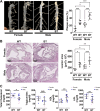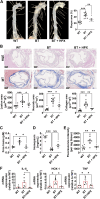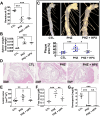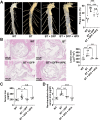Accelerated atherosclerosis in beta-thalassemia
- PMID: 37682237
- PMCID: PMC10908407
- DOI: 10.1152/ajpheart.00306.2023
Accelerated atherosclerosis in beta-thalassemia
Abstract
Children with beta-thalassemia (BT) present with an increase in carotid intima-medial thickness, an early sign suggestive of premature atherosclerosis. However, it is unknown if there is a direct relationship between BT and atherosclerotic disease. To evaluate this, wild-type (WT, littermates) and BT (Hbbth3/+) mice, both male and female, were placed on a 3-mo high-fat diet with low-density lipoprotein receptor suppression via overexpression of proprotein convertase subtilisin/kexin type 9 (PCSK9) gain-of-function mutation (D377Y). Mechanistically, we hypothesize that heme-mediated oxidative stress creates a proatherogenic environment in BT because BT is a hemolytic anemia that has increased free heme and exhausted hemopexin, heme's endogenous scavenger, in the vasculature. We evaluated the effect of hemopexin (HPX) therapy, mediated via an adeno-associated virus, to the progression of atherosclerosis in BT and a phenylhydrazine-induced model of intravascular hemolysis. In addition, we evaluated the effect of deferiprone (DFP)-mediated iron chelation in the progression of atherosclerosis in BT mice. Aortic en face and aortic root lesion area analysis revealed elevated plaque accumulation in both male and female BT mice compared with WT mice. Hemopexin therapy was able to decrease plaque accumulation in both BT mice and mice on our phenylhydrazine (PHZ)-induced model of hemolysis. DFP decreased atherosclerosis in BT mice but did not provide an additive benefit to HPX therapy. Our data demonstrate for the first time that the underlying pathophysiology of BT leads to accelerated atherosclerosis and shows that heme contributes to atherosclerotic plaque development in BT.NEW & NOTEWORTHY This work definitively shows for the first time that beta-thalassemia leads to accelerated atherosclerosis. We demonstrated that intravascular hemolysis is a prominent feature in beta-thalassemia and the resulting increases in free heme are mechanistically relevant. Adeno-associated virus (AAV)-hemopexin therapy led to decreased free heme and atherosclerotic plaque area in both beta-thalassemia and phenylhydrazine-treated mice. Deferiprone-mediated iron chelation led to deceased plaque accumulation in beta-thalassemia mice but provided no additive benefit to hemopexin therapy.
Keywords: atherosclerosis; beta-thalassemia.
Conflict of interest statement
No conflicts of interest, financial or otherwise, are declared by the authors.
Figures








References
Publication types
MeSH terms
Substances
Grants and funding
LinkOut - more resources
Full Text Sources
Medical
Molecular Biology Databases
Research Materials
Miscellaneous

